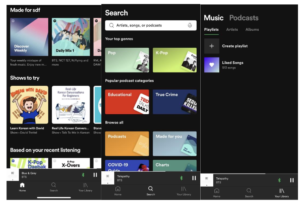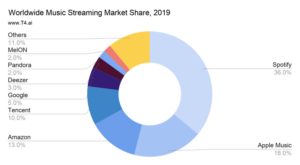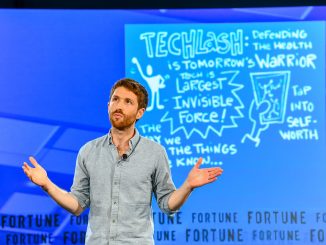
Introduction
Spotify, a Swedish-based audio streaming and media services provider, has revolutionized the music business and transformed the music industry by legally offering free, licensed music (Sun,2019). Unlike many illegal P2P file-sharing hosts/networks, Spotify based itself around the idea of a legal platform to distribute music online at a time when illegal file-sharing sites dominated this market segment. This is where Spotify transformed the music industry.
In this essay, I will explore the transformative impact that Spotify brought on the contemporary music industry by allowing its users to access free but licensed music. I will begin by discussing the launch and development of Spotify through an exploration of the company’s background. Then explore Spotify’s history and the business model it has created. Finally, Finally, I will discuss Spotify’s Internet ecology and what transformative impact it has had on our lives, society and economy.
WHAT IS Spotify?
Spotify is the biggest online audio streaming platform in the world. Now Spotify has 299 million monthly active users. People can enjoy millions of tracks and episodes on Spotify anywhere. Users not only can build their music collection on Spotify, but users can also browse friends, artist’s collections (Spotify,2020.). Spotify is like a giant music world where users can search for any songs they want to listen to at any time. Simple, instant, and free are Spotify’s advantages. It is a media company that combines advertising, music, technology, and finance. And Spotify provides people with licensed music at affordable prices (Morris,2015). The advent of online music has changed the main body of the music industry. The change from CDs, to MP3s, to online music streaming is a manifestation of the commodification of music as a commodity (Morris,2015). And the freedom to listen to music through Spotify is revolutionizing music as a commodity once again.

Spotify offers the Spotify free and Spotify premium two different types of accounts for users to choose from, with Spotify premium offering no listening time limits, no advertising, on-demand playback, and the ability to listen to music offline(Spotify,2020.).

Image: Irene Ding, screenshot, All rights reserved
The birth & growth of Spotify
Daniel EK, has been called the most powerful person in the music business. The CEO of Spotify was heavily influenced by Napster (Guardian,2017). The most popular music app before Spotify came along. Napster was one of the first websites to offer free and easy access to music using digital technology. It used P2P methods to enable people to receive free music online, but this infringed on artists’ music copyrights. Napster has brought the convenience and pleasure of free music to people. This also laid the foundations for the development of today’s streaming services (Sun,2019). As users have used Napster, they have come to expect a cheap and convenient way of accessing music. (Swanson, 2013, p211) The fight against music piracy was one of the main reasons EK wanted to create Spotify.
EK said that “I just wants people to be able to do what they want legally and easily”. (Stern,2012).
In 2008, Daniel and Martin Lorentzon officially launched Spotify in Stockholm, Sweden (Swanson, 2013, p208). Spotify was launched in Sweden and got success, but the subsequent implementations all ran into problems. Spotify has been available in the US since 2011 due to differences in each regional market. Now, Spotify is available in most regions of the world, but the content available is different in each region (Morris,2015, p201). Spotify is successfully starting to serve the world.
The technological challenge of the new modes of communication offered by the music industry and the Internet is an economy associated with new technologies, defined as the sharing economy (John,2016,p61). As a legal file-sharing platform in the sharing economy, Spotify provides an intermediate consumption platform for the sharing economy, and the sharing economy is digital. Spotify’s role as a technology platform offering free licensed music for collaborative consumption. Social media platforms generally provide this sharing technology to complete the sharing economy (John,2016,p65). Spotify is arguably a prime example of the sharing economy, as contributor EK intended to have a platform to share copyrighted music for free, rather than money.
Video explains how Spotify has developed
Source: CNBC,YouTube
Business model
- offering free but licensed music.
As Spotify’s business models mentioned, losing upfront is one of its most distinctive features, entirely different from a traditional business model. Because Spotify needs to pay a fee of copyrights for each song played. Whether it is playing for free users or premium users, Spotify is responsible for all the license fees (Richardson,2014,p2). This model helps the company build up users and convert more free users into premium ones, but it still does not change Spotify’s loss-making status, because Spotify has to pay a lot of licensing fees to record company. When Spotify was introduced to the United States, the loss of Spotify was severe. In 2011, the loss of Spotify was as high as 59Millions. Moreover, Spotify’s business model is based on the amount of music played, with Spotify only being able to generate higher revenues the more songs are streamed(Swanson,2013,p219).
- Advertising
Spotify is a media platform that generates much revenue from advertising. The advertising on Spotify has similar rules to those of the internet; advertising support is key to its growth (Patrick,2019, p4). It has been instrumental in the development of the platform’s economic model. Spotify’s advertising service is more like a platform service for advertisers and users. All three parties benefit from the advertising service, with advertisers being the most prominent factor supporting Spotify’s freemium status and a critical characteristic in achieving user and revenue growth (Patrick,2019,p4). While advertising still has not exactly helped Spotify turn a profit, it has helped Spotify on its way to creating streams.
Part of Spotify’s growth is due to its emergence as an emerging music service, offering it as a free service, which is then distributed, this processing creates a gift economy, enabling free commoditization (Morris,2015). Free music is Spotify’s most competitive service, which is why it can beat its competitors.
Internet ecology
Spotify acts as an intermediate medium that connects users and artists, with Spotify’s providers are the artists who provide the music, and Spotify’s revenue coming from the users who use the software. And Spotify is also trying to work with other platforms on the Internet to expand its own user base.
- Competitors
Spotify’s primary services are free and paid music available online, an easy to use the search engine for music, the ability to build own playlist, and the ability to share music on own social media home page. The company has become the main competitor of the music streaming platform. Apple Music, sound cloud, Pandora are Spotify’s main competitors(DW.2018). The services they offer are mostly similar to Spotify.
Click here check 10 competitors for Spotify.

- Regulators & Suppliers
As the largest streaming music provider, Spotify has a long history of working closely with several record labels, as its core suppliers are music from a variety of artists. However, Spotify is not usually in direct contact with musicians, but through distributors and labels(Swanson,2013,p218). The main ones are the three major record companies Universal Music Group, Sony Music Entertainment, and Warner Music Group. They provide the rights to a large number of songs for Spotify(Eriksson et al,2019). Of course, these record labels are the suppliers and the beneficiaries, and the labels receive royalties for sharing their songs via Spotify. Brad Sanders, Digital Content Manager at Secretly Canadian Distribution, said, “Spotify is a pleasure to work with because it is a level playing field for all artists and has more functions than iTunes. Spotify is a step in the right direction in replacing pirated music (Swanson,2013, p218).
- Investors
As Spotify has grown, it has become more than just a music company from Sweden. Because of its unique sense of digital innovation and its development, Spotify is now even closely linked to the United States’ financial interests. Until June 2015, Spotify raised $1.6 billion in seven rounds of investment from 26 major companies, including Coca-Cola, Goldman Sachs, and Technology Crossover Ventures. Furthermore, in 2016, it was successfully launched in the USA and Sweden (Patrick,2019,p4).
- Partners
Many sharing economy platforms start to have close cooperation with Spotify, such as Facebook and Uber. Spotify provides the user’s listening habits to be included in the Facebook personal homepage (Morris,2015, p189).
click hereview how did Uber work with Spotify.
Spotify Internet ecology

Transformative disruptive innovation
When it comes to Spotify’s innovations, the first and most significant change that Spotify has brought as a music streaming platform is a reshaping of the music market, successfully replacing illegal file sharing with streaming music. It replaces Napster, which used to share infringing music, by sharing legitimate music for free. Before Spotify came out, Napster used its dominant system, p2p (peer to peer) to swap three-quarters of its songs, a threat to record labels and artists whose copyrights were being threatened. However, Spotify has given a new twist to the music market and, in a way, has had a deterrent effect on the sharing of pirated files (Jordan,p214). Spotify allows users to listen to music for free and share it with others through Facebook(Migliore,2012), but it cannot download mp3 files. Spotify has reinvented two new definitions of music file-sharing: access and sharing(Jordan,p214). This is precisely the kind of music listening and functionality that people are looking for, and it has the same appeal as the Napster to people.
Spotify has not only been transformative in the fight against file piracy, but Spotify has also had a transformative economic impact, pioneering the business model for streaming music and providing a long-term and stable income for record labels and musicians (POMALES,n.d.). Spotify is a powerful streaming service built through the Internet, more like social media, that has changed how fans discover artists and consume music (Chertkow, Feehan, 2016). Fans can follow their favorite artists, Spotify notifies fans when an artist releases a new song, fans can actively participate in music events and play songs. Fans can build their song lists and receive royalties for each music artist played. Spotify allocates 70 percent of royalties to those who own the music’s rights on a pro-rata basis according to its popularity (Swason, 2013, p209). Average $.006 and $.0084 cents per Spotify stream (POMALES,n.d).It is because Spotify gives a percentage of each stream’s revenue to the artist or record label that artists are beginning to earn a steady, long-term income from streaming music. The way music is distributed heavily influenced by the Internet, and the music industry is under serious threat, if not ‘dead,’ in the face of illegal file sharing and music artists’ ability to circumvent traditional methods of distribution(Johansson, Werner,2018,p12). As people enjoy the thrill of free music files, sales of physical records have plummeted in the 21st century, and artists’ financial resources have been hit hard. Therefore, Spotify, a new music streaming method that pays royalties to artists, effectively improves artists’ economic situation suppressed by the emergence of the Internet. Spotify’s birth can be said to help the production and consumption transformation of cultural and media products (Johansson, Werner,2018,p12). The ability to listen to different artists’ creations on streaming platforms, where consumers pay once or for free and artists’ licensed fee are repaid through the platform, is also an attractive change for music consumers.
Final notes:
Overall, Spotify has become an effective form of internet transformation by using its unique features to offer free and authentic music, introducing a new business model for the music market and reducing file piracy, providing an easier way for users and a stable financial source of income for artists.
Reference list:
Berenji, P. (2020, May 20). Photo by Puria Berenji on Unsplash. Retrieved November 22, 2020, from https://unsplash.com/photos/eOLiis02ixw?utm_source=unsplash
Chertkow, R., & Feehan, J. (2016, July). Make Spotify work for you: maximize streaming service features to grow your fanbase and generate revenue. Electronic Musician, 32(7), 54+.
CNBC(2020,July 18). How Spotify Dominates Apple, Google And Amazon In Music
.Retrieved from https://www.youtube.com/watch?v=6viSSo12-PQ
DW.(2018, March 4). Spotify: How a Swedish startup transformed the music industry: DW: 03.04.2018. Retrieved November 22, 2020, from https://www.dw.com/en/spotify-how-a-swedish-startup-transformed-the-music-industry/a-43230609
Eriksson, M., Fleischer, R., Johansson, A., Snickars, P., & Vonderau, P. (2019). Spotify teardown : inside the black box of streaming music . The MIT Press.
G.(2017, February 10). Spotify’s Daniel Ek named most powerful person in the music business. Retrieved November 18, 2020, from https://www.theguardian.com/music/2017/feb/10/spotify-daniel-ek-most-powerful-person-music-business
Music Streaming Market Share. (2020, August 16). Retrieved November 22, 2020, from https://www.t4.ai/industry/music-streaming-market-share
POMALES, S. For Better or For Worse: Spotify and the Music Industry.
Johansson, S., Werner, A., Åker, P., Goldenzwaig, G. (2018). Streaming Music. London: Routledge
John, N. A. (2016). Sharing economy. The age of sharing.
Morris, J. (2015). Selling Digital Music, Formatting Culture . University of California Press,. https://doi.org/10.1525/9780520962934
Migliore, M. (n.d.). An Update on Spotify. Retrieved November 22, 2020, from http://www.thembj.org/2012/12/an-update-on-spotify/
Richardson, J. H. (2014). The spotify paradox: How the creation of compulsory license scheme for streaming on-demand music platforms can save the music industry. UCLA Entertainment Law Review, 22(1), 45-[i].
Spotify. (n.d.). Retrieved November 16, 2020, from https://www.spotify.com/uk/about-us/contact/
Spotify. (n.d.). Retrieved November 16, 2020, from https://www.spotify.com/us/premium/#PLANS
Stern, J. (2012, December 10). Spotify Founder Daniel Ek Wanted to Create Something ‘Better than Piracy’. Retrieved November 22, 2020, from https://abcnews.go.com/blogs/technology/2012/12/spotify-founder-daniel-ek-wanted-to-create-something-better-than-piracy/
Sun, H. (2019). Digital Revolution Tamed The Case of the Recording Industry . Springer International Publishing.
Vonderau, P. (2019). The Spotify Effect: Digital Distribution and Financial Growth. Television & New Media, 20(1), 3–19. doi.org/10.1177/1527476417741200
Wcs. (2020, June 03). TOP 10 SPOTIFY COMPETITORS in 2020. Retrieved November 22, 2020, from https://whatcompetitors.com/spotify/


